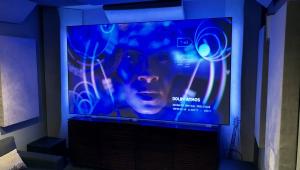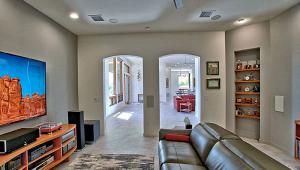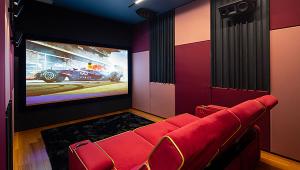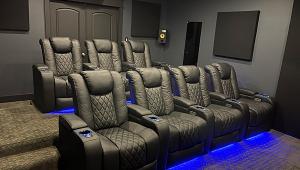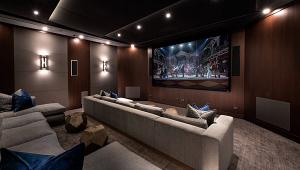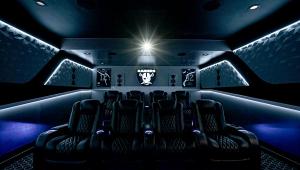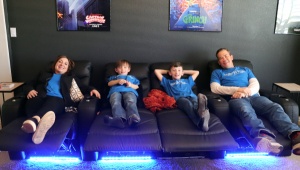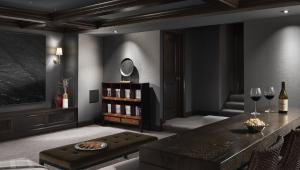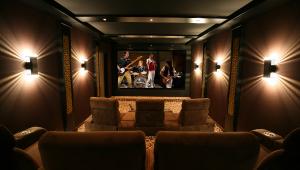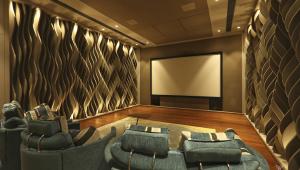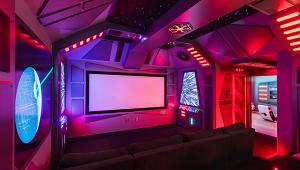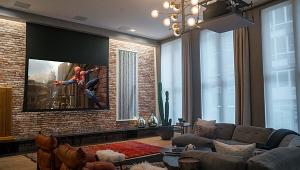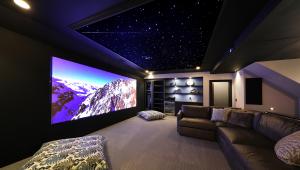Advice From an Audio Insider

Dr. Floyd Toole lives a charmed life. He's lucky enough to have a career that is also a lifelong passion. As he leans against his kitchen counter, glass of Pinot in hand, he muses on his life and career as an audio and acoustical engineer. Now as the vice president of acoustical engineering for Harman International, he spends his days helping others understand acoustic design, conducting research, and designing audio products that will sound good in any room, not just the anechoic chamber of a speaker lab or a highly treated dedicated theater.
The son of a teacher and an accomplished do-it-yourself dad, Toole grew up playing with his father's power tools and building model airplanes. He had a natural curiosity for how things work. As early as the 1950s, Toole and his dad were building loudspeakers from scratch. That was just the beginning of his insatiable audio hobby, which has now spanned decades and includes, oh, minor stuff—like holding the senior research officer position in the acoustics and signal-processing group of the National Research Council Canada, receiving an Audio Engineering Society (AES) Publications Award for papers on technical measurements of loudspeakers and listeners' perceptions, and being honored with a fellowship and the AES Silver Medal Award for his work on subjective and objective evaluation of audio devices.

For Toole, the line between career and hobby is enviably blurred. In fact, his professional audio career has been shaped in direct response to the real-world issues he encounters in his private life. "Several of the significant knowledge breakthroughs I've experienced in my career have come about from my personal experience at home," explains Toole. "When my wife, Noreen, and I were planning our A/V room, for example, we realized that a dedicated theater didn't fit our lifestyle. We are not the kind of people who disappear into the dark for two hours with a bowl of chips and a drink. We enjoy the view from our media room of the garden and pool outside. We want to experience the space of the rest of the house, and not feel totally compressed by blackness."

The desire to have an A/V room that would function as a regular living room for entertaining, reading books, and enjoying life—but that would also look and sound good—presented a challenge for Toole. Like most of our allocated A/V spaces, his great room, which he'd earmarked for the main A/V system, was not the ideal space for good audio. While the room is rectangular, which makes acoustics a bit more manageable, it's slightly asymmetrical, with large windows along one wall. A third of the opposite wall opens up to the kitchen area.
"In a stubborn sense, I felt there had to be solutions to my own problems," says Toole. "Well, we've found those solutions and, to a large extent, have incorporated them into Harman products." Because of the unique circumstances of his own room, and the unpredictable nature of rooms everywhere, Toole wanted to design speakers that would sound awesome in any room. Instead of taking your speakers home, hitting play, and crossing your fingers, new speakers would be designed to sound great, regardless of wildly varying acoustics from one consumer's room to another's. "In speaker design, we treat sound above 300 to 400 hertz very differently than sound below this frequency range," says Toole. "If you design a speaker to have a smooth and flat on-axis response above this range, and, if they have relatively constant directivity, speakers become room friendly, increasing the probability that they'll sound good in a wide variety of room spaces." All of the loudspeakers designed at Harman aspire to this objective.

Toole's own media room takes this practical approach to design. It is a friendly room without complicated acoustic treatment. On first glance, in fact, there is no obvious acoustical treatment at all. However, the carpet is dense clipped pile with a half-inch of felt below it, acting as an acoustic absorber. Toole believes that the wall immediately behind the listeners should be acoustically absorptive, so the drapery at the rear of the room is heavy velour. Above the velour drapes, Toole has completely disguised five inches of fiberglass, which acts as a broadband absorber, removing any opportunity for sound to bounce between the front and back of the room. The back wall is also mostly dark, preventing the reflection of light back onto the front-projection screen.
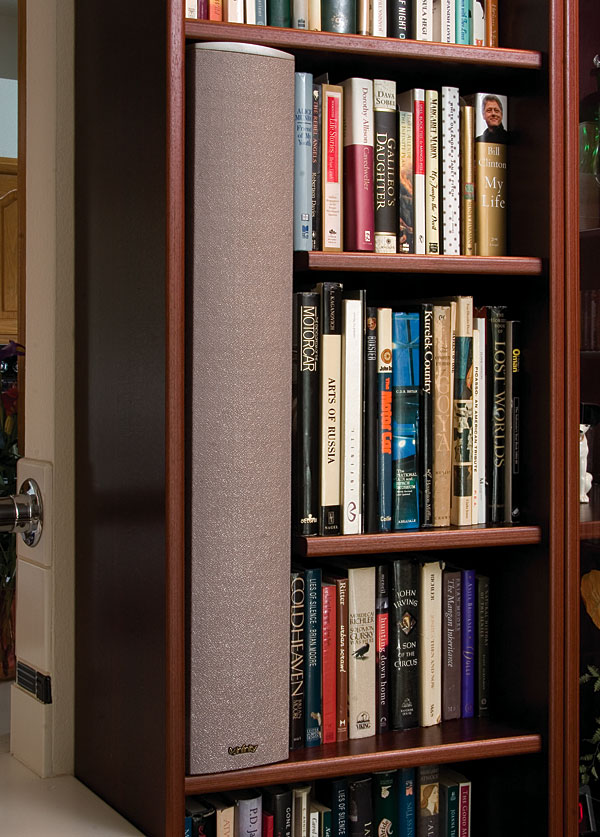
Bookcases, which are wonderful diffusers and absorbers, help to break up the sound reflecting between the side walls. Toole has done a rather novel thing by putting rear surround speakers in his bookshelves and actually putting books in the bookshelf, as well. "When you put a speaker in a cavity, it reacts with the space around it. If you have a bookshelf, read some books, and use them to fill up the space," says Toole. "A lot of entertainment furniture encourages poor audio performance by showing pictures of speakers in empty cabinets." Four subwoofers (see sidebar, "The Case for Multiple Subwoofers") are either hidden or somewhat disguised and are equipped with proprietary signal processing to achieve similarly good bass in all of the seats.
It's certainly interesting that such an accomplished acoustic engineer hasn't given his room a complete acoustic remodel, using professional devices such as bass traps, diffusers, and acoustic panels. But Toole, like you or me, is a practical person living a normal life. He effectively tamed his room's acoustics by using traditional room constructs, which makes the room look like a room.
The challenge then becomes finding a speaker that combines excellence in audio performance with some degree of aesthetics. "People talk about WAF [Wife/Woman Acceptance Factor] as if only women respond negatively to an unattractive room or object," says Toole. "The goal is to find ways to integrate speakers into the fabric of your room in a way that allows them to function well acoustically—and yet not dominate the visual landscape." The Tooles, in fact, find enough pleasure in audio that they are willing to look at their speakers, so the visual "damage" they impose is minimal.

What about in-wall and in-ceiling speakers? Don't they provide an aesthetic audio solution? This acoustic engineer advises that, while a wall or ceiling can make an excellent acoustical environment for a loudspeaker from the sound-quality perspective, the problem is that we localize the sound as originating from the loudspeaker location—if that is a ceiling, we will forever be entertained by 'heavenly' voices. "My recommendation to installers is to use all of their abilities in human persuasion to convince their clients that at least the left, center, and right channels should be in-wall, on-wall, or free-standing speakers placed close to ear level," says Toole. "You can get away with ceiling locations for surround channels, but even then it's not ideal. This is why we now are enjoying the luxury of seriously competent engineering so that good sound can be achieved in visually interesting and aesthetic packages. Speakers are now like little pieces of sculpture." The JBL TiKs , for instance, reside in Toole's bedroom, adding to rather than detracting from the appearance of the space. He compares the visual presence of speakers to that of a grand piano: "A grand piano is an imposing sight, dominating a domestic-sized room. It's not necessarily visually beautiful, but it's interesting and attractive in our associations with the sounds that can emerge from it—hopefully there is someone in the house who can actually play it. A visually appealing set of loudspeakers can be similarly pleasing but more rewarding in that they can play any kind of music or movies for everyone to enjoy."
Improperly placed speakers can also be disorienting because the sound may not attach to the visual image onscreen. A major part of Toole's craft is psychoacoustics, a science that relates what we perceive to what really exists in the physical world. Psychoacoustics also explores the relationship between what we hear and what we see. "Vision is a factor in the localization of sound," explains Toole. "Where we perceive sounds to come from is dependent on what we see. When you close your eyes and focus, you'll notice that a lot of the sound in a home theater comes from the center channel. The left and right speakers play a supporting roll, not a dominant one." That's why paying attention to the quality of your center channel is important. According to Toole, 95 percent of broadcast TV comes out of the center channel and about 80 to 90 percent with movie soundtracks. This is because, in the film business, audio is often simplified due to the fact that directors chop and change right up to the last minute. While visual edits can be made instantaneously, the soundtrack is much more complicated. If filmmakers do a quick and sloppy sound edit, the visual image might be fine, but the audio will suffer. Subtle differences in ambiences, such as a voice coming out of the left and then the right speaker, can be upsetting, so filmmakers simply don't allow that to happen by keeping the soundtrack fairly simple. If your center doesn't perform well, your system is crippled.
While Toole is an audio-oriented guy, one of the first things he considered when buying a home was the video wall. "I tried to find a house where the family room would allow me to have a rectangular viewing arrangement with the display on one wall and not in a corner. I failed. So we ended up with a house designed with the horse-and-cart-era wisdom that the hearth is the center of family life," says Toole. "But you don't find many people sitting around the fireplace, telling stories, or simply talking anymore. There are many houses with fireplaces in the center of a wall where the video display should be, forcing you to put a video display in the corner." For a short period, Toole did as many do, and resigned himself to relegating the video display to the corner of the room.
But, finally, the desire to have a seriously large screen required moving the fireplace and turning the room completely around. He relocated the fireplace to a corner and put an equipment rack and front projector in the cavity left by the original fireplace. He then moved the video screen to the opposite wall, which was advantageous because it is always shaded. Here you'll find a 65-inch Sony CRT rear-projection TV, which Toole and his wife can view comfortably in the daytime with the windows open. Around the video wall, there are lighted alcoves for sculpture, which also serve as acoustical diffusers. A 10-foot-diagonal 16:9 Stewart Filmscreen Firehawk screen descends from the ceiling for more serious viewing, with a Sharp DLP projector doing the video honors. "But, for a screen this size, I need more light output, a three-chip device. I've been waiting for that part of the industry to develop smaller, quieter, and less-expensive products—we may now be there," Toole says, relating to the rest of us who can't yet afford these projectors.
It's comforting to know that Floyd Toole is a practical guy that deals with the same issues we all deal with when we're trying to install our systems—despite the fact that he is essentially a god in the world of audio. But the one overarching theme that I took away from my time with Toole was the mantra that audio equipment is "science in the service of art." Toole's philosophy, which he applies to all his audio endeavors, is that the audio industry exists to help us enjoy our music and movies. In fact, Toole might not be so interested in the pursuit of audio if it weren't for the jazz that pumps through his system in the evenings, the Mozart he listens to on Sunday morning, or a screening of Some Like it Hot on a Friday night. Let's hope Dr. Toole keeps pursuing this audio science in the service of art, because if he keeps applying his personal audio struggles to his professional life, we'll all benefit.
How It Works For You
• Are Your Speakers Big Enough? Make sure the capacity of your room jibes with the capability of your speakers. "I often see large rooms with totally inadequate loudspeakers," says Toole. Your installer/salesperson can help you determine which speakers might be appropriate for your room. Have your room measurements on hand when you shop, and think about your listening habits. Do you want to play movies at cinema sound levels, or are you forced to keep the volume down? It can make a big price (and size) difference!
• Invest in a Good Center Channel. The bulk of the audio in TV and movies comes out of the center channel speaker. If it isn't up to snuff, your system will suffer. In fact, the left, center, and right speakers should be similar in performance.
• Find a Shaded Wall. If you have a room with windows and you have the choice, put your video display along a wall that the sun does not reach. Obviously, the time of day matters. You can place a direct-view display with its back towards the sun, if nothing else works.
• Get Creative With Acoustics. Bookshelves, alcoves, and heavy carpet can all help tame your room's sound. Try to put absorptive acoustic material, such as heavy drapery, at the rear of your room, but don't go overboard with absorption. Remember that furnishings that reflect, scatter, or diffuse sounds actually make the existing absorption more effective.
The Case for Multiple Subwoofers
By Dr. Floyd Toole
At low frequencies, room interactions take on a special flavor because of the way acoustical standing waves dominate what we hear. The quantity and quality of bass sound is determined as much by the room and how it is set up as it is by the subwoofers themselves. In the investigation of many rooms over the years, I would estimate that 80 percent have serious bass coloration—too much, too little, boomy, uneven, and so on. Add to this the inevitable seat-to-seat variations in bass, and it is clear that a lot of consumers need help. This situation is an enormous frustration for speaker manufacturers. Short of hiring an acoustical consultant, and being willing to rearrange the furniture and possibly rebuild the walls, what can be done? There are two steps in the solution. The first step is to decide how many listeners should have expectations of good bass. Seat-to-seat variations in bass quality can be huge. One subwoofer is fine for one listener, but multiple listeners means multiple subwoofers.

The approach we adopted was to look for a more general solution to the problem, one that could be trusted to work in many rooms. It turns out that there are, in fact, two solutions: one for simple rectangular rooms, and one for rooms with more complicated shapes.
Rectangular rooms. These rooms must have mostly flat walls, floor and ceiling, and no large openings to other spaces. Summarizing the results of an elaborate study, the diagram below shows some of the recommended subwoofer arrangements.
Non-rectangular rooms. Things get much more complicated in these rooms; there are no safe generalizations, so every room must be treated individually. Inevitably, acoustical measurements are necessary, and some form of optimization algorithm is needed to work through the variables. We are currently working on products in the JBL Synthesis speaker and Harman Kardon receiver lines to be announced within months of this writing (possibly by the time you read this), that provide signal-processing solutions using multiple subwoofers to achieve uniform bass for multiple listeners in rooms of arbitrary shape.
- Log in or register to post comments


The knowledge in this essay has occasionally been useful for my work. Play the tiny fishing game to learn how to score goals like the players you've always admired.

One subway surfers illustrative example he shares is about his and his wife Noreen's decision to plan their A/V (audio/visual) room. They realized that a dedicated home theater room wouldn't align with their lifestyle.

So this is basically for my current location, advice for audio insider

Malayalaminfo provides the latest news and informative articles in the Malayalam language.

Psc Thulasi is the best blogging website that talks about Kerala Psc. You will get everything related to Kerala Psc from this site.

Psc Thulasi is the best blogging website that talks about Kerala Psc. You will get everything related to Kerala Psc from this site.

Get the latest Malayalam Movies updates from moviesmalayalam.in

Book Your Houseboats Houseboats in Alleppey

Now as the vice president of acoustical engineering for Harman International, he spends his days helping others understand acoustic design, conducting research, and designing audio products that will sound good in any room, not just the anechoic chamber of a speaker lab or a highly treated dedicated theater.

You can check Alleppey Houseboat Rates for 1 Day
